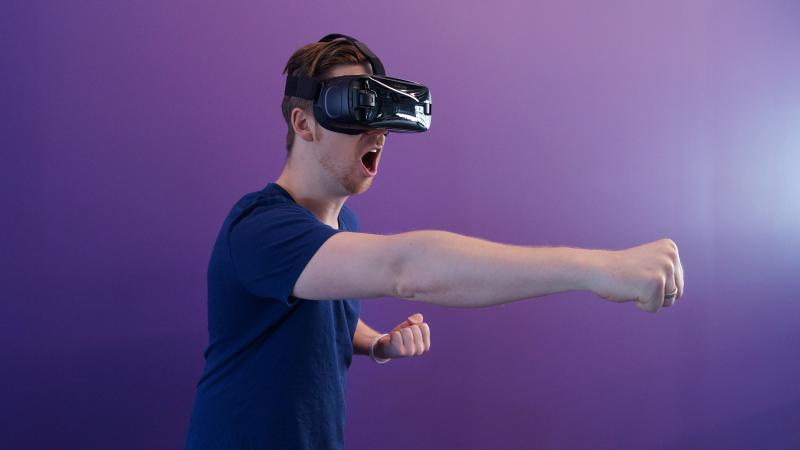


Students of Digital Mental Health teamed up to write blog posts. You can read the three best posts of academic year 2022- 2023 here: on virtual reality and pain reduction, social media and alcohol abuse among adolescents, and binge watching.
By Lucas Vervaecke & Alena Thöni
There’s nothing #technology can’t do. Recent #VR research shows promising results: is #virtualreality the innovative solution to give patients a break from #chronicpain?
Chronic pain is difficult to treat, and it often happens that painkillers are insufficient. It is also the case that the side effects and costs of these are disruptive for long-term use (Wittkopf et al., 2019). But before we start with possible solutions, we first need to clarify how we end up with pain. According to the neuromatrix theory of pain, cognitive, sensory, and affective inputs, as well as factors that influence them (such as attention), can partially change your pain and the response hierarchy disappears (Melzack, 2001). So, for example, if you are well distracted then it is possible that you feel this pain much less, virtual reality seems to be a very good way for this method.
But distraction isn't the only way VR is being used to reduce pain perception. From a review by
Ahmadpour et al., (2020) they were able to recognize 3 targets of VR interventions.
The use of VR for healthcare was pioneered by Hoffman et al. (2000) who had developed a VR video game (SnowWorld). This has been successfully used during the care of severe burns to reduce patients' pain perception, in other words to distract them from the pain. It didn’t solve the problem, but the patients had a significant reduction in pain (65% of patients had an 34% reduction in worst pain).
Several games have also been made that did not necessarily only change the focus as a goal, but where this simply fits into this category. An example of this is Pizkorz and Czub's (2018) trial that used a Multiple Object Tracking paradigm during a painful procedure. That is a virtual game where players must remember and follow multiple moving objects. Here, the players had reported a significantly lower pain intensity compared to the control group (mean pain intensity = 15.16 ± 20.51 vs. 37.05 ± 30.66).
The trial was conducted to teach patients with chronic pediatric headaches to better control their mental state. By focusing to get from stress to a calmer mental state, where they then receive immediate visual feedback. Each person who participated experienced significant headache relief (Shiri et al., 2013).

Implementing games in healthcare is nothing new. Games have been tested before to distract people from their pain. Unfortunately, VR treatment for chronic pain is relatively new and more research needs to be done. It is also the case that all treatment methods (not just VR) of chronic pain do not work equally well for everyone.
Following the explanation of how VR can be used in pain therapy the question arises, what the advantages and disadvantages of this technology, used in pain treatment, are. There’s a wide range of arguments in this regard. One of the biggest advantages is that the use of VR technologies in pain treatment offer a treatment without pharmaceutical alternatives (Ahmadpour et al., 2020).
On the other hand, it is also important to be aware of the disadvantage of accessibility as well as occurring difficulties in the application, depending on the intensity of pain. Therefore, people with complicated health needs are excluded from the therapy, although they would need it the most (Ahmadpour et al., 2020), just because it is too complicated to apply it to an impaired body. Yet in the case of stroke patients, VR therapy proves to be effective because it is not only analgesic, but one can also target and exercise damaged brain regions, thus counteracting the lesion (Sato et al., 2010). Probably the most obvious and therefore most promising advantage of VR use is the ability to provide patients with a pain-free environment that distracts from acute pain during painful medical procedures, but also acts as an escape possibility for chronic pain patients (Shiri et al., 2013).
When we talk about disadvantages, there’s a need to mention the design of the VR applications. If it should really be used as an alternative therapy to relief pain, the design must be suitable for the patient’s context. The VR experience must be satisfying and non-frustrating for the user, which means it’s important to include normal positive environments in the VR (Garrett et al., 2020).
Also, the technical operation seems to often be a barrier for the effective usage of VR applications. Considering, that people with chronic pain are often not able to walk around a room or even stand up right (Garrett et al., 2020). So, to conclude this part, yes VR seems very promising in the treatment of chronic pain although it must be mentioned, that there are no peer reviewed studies which confirm the efficacy in chronic pain on a long-term scale (Gromala et al., 2015).
Considering the ongoing opioid crisis, we see especially in North America and industrialized nations (Gromala et al., 2015), having an option to treat pain and relief the patients is promising and motivating. The VR pain therapy offers a treatment completely without the risks of the side effect pharmaceutic alternatives have, f.e. opioid dependency (Ahmadpour et al., 2020).
But, to get to the point where this kind of therapy can be offered to all patients with chronic or acute pain, the applications need to be optimized. That’s why it’s recommended to include the patients in the design process because pain experiences differ from individual to individual.
To sum it up, VR can be a very promising application to relief people from pain or at least offer them a temporary escape out of their painful reality.
